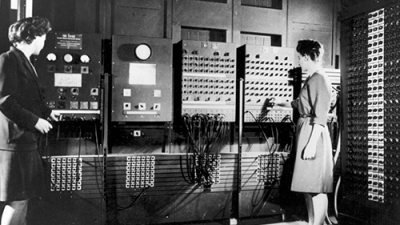
ENIAC (Electronic Numerical Integrator and Computer) is the world’s first general-purpose computer designed in 1943. Although it took days to program, ENIAC could perform thousands of calculations in a second. That power required some serious hardware. ENIAC was large enough to live in, weighed more than 30 tons (27 t), and took up the space of a typical single-family house. Built before smaller and more efficient transistors, ENIAC relied or more than 17,000 soda-can-size vacuum tubes that often malfunctioned when the massive machine was powered up. ENIAC’s operators came up with a simple solution for that problem: They never turned it off. The computer ran continuously for more than seven years. It was even rumored (falsely) that ENIAC’s massive power needs were responsible for occasional power outages in the nearby city of Philadelphia, Pennsylvania, U.S.A.
Picture Credit : Google

